The Severity of Environmental Pollution in the Developing Countries and Its Remedial Measures
Abstract
:1. Introduction
2. Materials and Methods
2.1. The Study Area
2.2. Model Used in This Study
2.3. Data and Information Collection
2.4. Structure of the Questionnaire
2.5. Sampling Technique and Sample Size Determination
2.6. Data Processing and Analysis
3. Results
3.1. Demographic Information of Respondents of the Study Area
3.2. Residents’ Opinion about the Causes and Types of Environmental Pollution
3.3. Residents’ Remarks about Sources of Significant Environmental Pollution in the Study Area
3.4. Observation of the Duration and Times of Major Environmental Pollutions in the Study Area
3.5. Effectiveness of Current Environmental Programs and Respondents’ Media Preference in Environmental Information
4. Discussion and Policy Implications
- Discouraging rural–urban migration at the national level: It is essential to decentralize all public amenities by displacing the garment industries from Dhaka City, growing employment opportunities in rural areas, using modern technology in agriculture, and establishing better healthcare centers and educational institutions all over the country.
- Forming an environmental committee at the local level: Every city ward authority (the lowest administrative unit) can create an environmental committee that directly discusses environmental information with the local people through leaflets, workshops, seminars, cleaning programs, etc.
- Improving solid waste management at the community level: A waste management committee can be formed at the community level that regulates waste disposal for overall environmental management. The committee can inspire the people to keep their domestic waste separately and properly dispose of it.
- Starting an environmental education subject at the institutional level: A mandatory environmental awareness-related subject can be introduced in primary schools, where children will practice how to use resources and to clean their surrounding environments.
- Making films, documentaries, and drama for environmental awareness: Environmental information based on documentaries, movies, advertisements, and drama can be made and shown on television and shared on social media, including YouTube, for mass awareness.
- Encouraging environmentally friendly transportation: Eco-friendly vehicles can reduce air pollution by replacing fossil fuels to clean energy such as solar and wind energy.
- Regulating the dust from roads and construction sites: Building or construction sites must have a solid fence during construction. Road pavement, regular washing, cleaning, and water spraying, particularly in the dry season, can reduce the road’s dust.
- Reducing the price of environmentally friendly products: Lessening the value of eco-friendly products can attract consumers to purchase them.
- Increasing the tree plantation for noise pollution reduction: A huge number of trees inside and surrounding schools, parks, hospitals, markets, and recreational places can control noise pollution.
- The three Rs (reuse, reduce, and recycle) of resources: Reusing resources can diminish waste from the environment and save money. Reducing the emission of greenhouse gases and debris can help to build a sustainable environment for future generations. People should be encouraged to mend and maintain their daily essential products and recycle them.
- Evaluating environmental impacts: Before starting any development works, the proper authority must assess the environmental effects. A skilled workforce should be recruited in the Department of Environment, Dhaka, Bangladesh, for its early evaluation process and surveillance.
5. Conclusions
Author Contributions
Funding
Institutional Review Board Statement
Informed Consent Statement
Data Availability Statement
Acknowledgments
Conflicts of Interest
References
- Rahman, K.M.; Rummana, R.; Aziz, S.; Nishat, B. Urban pollution in Dhaka City: A tri-partite qualitative model for alleviation and prevention. In Proceedings of the International Conference on Sustainable Urban Environmental Practices, Chiang Mai, Thailand, 28–31 October 2008; pp. 1–20. [Google Scholar] [CrossRef]
- State of Global Air. A Special Report on Global Exposure to Air Pollution and Its Disease Burden. Institute for Health Metrics and Evaluation’s Global Burden of Disease Project and the Health Effects Institute, 2017. Available online: https://www.stateofglobalair.org/sites/default/files/SOGA2017_report.pdf (accessed on 26 November 2018).
- Sheraj, S. Social and economic life affected by environmental degradation in China and Bangladesh. Int. J. Sci. Bus. 2017, 1, 119–139. [Google Scholar]
- WHO. Environment and Health in Developing Countries. Health and Environment Linkages Initiative (HELI). 2021. Available online: https://www.who.int/heli/risks/ehindevcoun/en/index1.html (accessed on 2 February 2021).
- The World Bank Group. Pollution. 2021. Available online: https://www.worldbank.org/en/topic/pollution#1 (accessed on 2 February 2021).
- Omoju, O. Environmental Pollution Is Inevitable in Developing Countries. Breaking Energy. 2014. Available online: https://breakingenergy.com/2014/09/23/environmental-pollution-is-inevitable-in-developing-countries/ (accessed on 2 February 2021).
- Nayar, R. Air Pollution in South Asia: Silent Killer Continues Its Advance. Media India Group (MIG), 2019. Available online: https://mediaindia.eu/environment/air-pollution-in-south-asia/ (accessed on 27 February 2021).
- World Health Organization. Global Urban Ambient Air Pollution Database. Available online: http://www.who.int/phe/health_topics/outdoorair/databases/cities/en/ (accessed on 31 July 2020).
- The Daily Star. Dhaka Air Ranked World’s 3rd Most Polluted. WHO, 2018. Available online: https://www.thedailystar.net/city/air-pollution-in-bangladesh-dhaka-air-ranked-world-3rd-most-polluted-who-1570399 (accessed on 17 November 2018).
- Islam, S.; Rana, M.P.; Ahmed, R. Environmental perception during rapid population growth and urbanization: A case study of Dhaka city. Environ. Dev. Sustain. 2013, 16, 443–453. [Google Scholar] [CrossRef]
- Corner, R.J.; Dewan, A.M. Introduction. In Dhaka Megacity: Geospatial Perspectives on Urbanisation, Environment and Health; Dewan, A., Corner, R., Eds.; Springer: Dordrecht, The Netherlands; Heidelberg, Germany; New York, NY, USA; London, UK, 2014; pp. 1–22. [Google Scholar] [CrossRef]
- Ahmed, S.; Nahiduzzaman, K.M.; Hasan, M.U. Dhaka, Bangladesh: Unpacking challenges and reflecting on unjust transitions. Cities 2018, 77, 142–157. [Google Scholar] [CrossRef]
- Banglapedia. Dhaka, Geology. 2014. Available online: http://en.banglapedia.org/index.php?title=Dhaka,_Geology (accessed on 22 November 2018).
- Siddiqy, R. Urban environment and major challenges in sustainable development: Experience from Dhaka City in Bangladesh. South East Asia J. Public Health 2017, 7, 12–16. [Google Scholar] [CrossRef] [Green Version]
- Rahman, A.; Rahman, A.; Dey, B.K. Attitude of the community people towards health and environmental hazards of tanneries in Dhaka. Int. J. Indian Psychol. 2016, 3, 175–184. [Google Scholar] [CrossRef]
- The Daily Star. Pollution the Killer. 2018. Available online: https://www.thedailystar.net/environment/environment-pollution-in-dhaka-bangladesh-18000-died-world-bank-report-1634566 (accessed on 17 November 2018).
- Rahman, M.; Mahamud, S.; Thurston, G.D. Recent spatial gradients and time trends in Dhaka, Bangladesh, air pollution and their human health implications. J. Air Waste Manag. Assoc. 2019, 69, 478–501. [Google Scholar] [CrossRef]
- Alam, M.Z.; Armin, E.; Haque, M.; Halsey, J.; Qayum, A. Air pollutants and their possible health effects at different locations in Dhaka city. J. Curr. Chem. Pharm. Sci. 2018, 8. [Google Scholar] [CrossRef]
- The Daily Star. Dhaka’s Air Ranked Among the Worst, Again. 2018. Available online: https://www.thedailystar.net/city/dhaka-air-ranked-among-the-worst-in-the-world-according-to-us-environmental-protection-agency-1549990 (accessed on 18 May 2018).
- IQAir. 2019 World Air Quality Report Region & City PM 2.5 Ranking. 2020. Available online: https://www.iqair.com/world-most-pollutedcities/world-air-quality-report-2019-en.pdf (accessed on 19 December 2020).
- Bashar, T.; Fung, I.W. Water Pollution in a Densely Populated Megapolis, Dhaka. Water 2020, 12, 2124. [Google Scholar] [CrossRef]
- Haq, M.; Islam, M.; Ali, M.; Haque, M.; Akhand, M. Status of noise pollution in mixed areas of Dhaka city: A GIS approach. J. Environ. Sci. Nat. Resour. 2012, 5, 9–17. [Google Scholar] [CrossRef]
- Salequzzaman, M.; Davis, J.K. Environmental education and environmental management in Bangladesh and their sustainability. Environ. Inf. Arch. 2003, 1, 70–82. [Google Scholar]
- Islam, N. Public awareness about environmental issues: Perspective Bangladesh. Asian Aff. 2008, 30, 30–56. [Google Scholar]
- Meinhold, J.L.; Malkus, A.J. Adolescent environmental behaviors. Environ. Behav. 2005, 37, 511–532. [Google Scholar] [CrossRef]
- Corburn, J. Bringing local knowledge into environmental decision making. J. Plan. Educ. Res. 2003, 22, 420–433. [Google Scholar] [CrossRef] [Green Version]
- Choudri, B.S.; Baawain, M.; Al-Sidairi, A.; Al-Nadabi, H.; Al-Zeidi, K. Perception, knowledge and attitude towards environmental issues and management among residents of Al-Suwaiq Wilayat, Sultanate of Oman. Int. J. Sustain. Dev. World Ecol. 2016, 23, 433–440. [Google Scholar] [CrossRef]
- Chen, Y.; Zhang, Z.; Shi, P.; Song, X.; Wang, P.; Wei, X.; Tao, F. Public perception and responses to environmental pollution and health risks: Evaluation and implication from a national survey in China. J. Risk Res. 2015, 20, 347–365. [Google Scholar] [CrossRef]
- Alom, M.M.; Khan, M.Z.H. Environmental and social impact due to urban drainage problems in Dhaka City, Bangladesh. Int. J. Eng. Adv. Technol. 2014, 3, 128–132. [Google Scholar]
- Swapan, M.S.H.; Zaman, A.U.; Ahsan, T.; Ahmed, F. Transforming urban dichotomies and challenges of south asian megacities: Rethinking sustainable growth of Dhaka, Bangladesh. Urban Sci. 2017, 1, 31. [Google Scholar] [CrossRef] [Green Version]
- Rahman, M.; Paul, S.; Biswas, K. Earthquake and Dhaka City-An approach to manage the impact. J. Sci. Found. 2013, 9, 65–75. [Google Scholar] [CrossRef] [Green Version]
- Chowdhury, M.H.I. A Short City Profile of Dhaka City: Adaptation Issues for Climate Change? 2010. Available online: http://resilient-cities.iclei.org/fileadmin/sites/resilient-cities/files/docs/B4-Bonn2010-Hamidul.pdf (accessed on 22 November 2018).
- Dhaka Structure Plan 2016–2035. Chapter 02—Dhaka: Past and Present. Available online: http://www.rajukdhaka.gov.bd/rajuk/image/slideshow/Dhaka_Structural_Plan.html (accessed on 23 July 2018).
- Dhaka Population 2018. World Population Review. 2018. Available online: http://worldpopulationreview.com/world-cities/dhaka-population/ (accessed on 18 November 2018).
- Banglapedia. Dhaka City Corporation. 2014. Available online: http://en.banglapedia.org/index.php?title=Dhaka_City_Corporation (accessed on 22 November 2018).
- The World Bank. Dhaka: Improving Living Conditions for the Urban Poor; Bangladesh Development Series-Paper No. 17; The World Bank Office: Dhaka, Bangladesh, 2007; Available online: http://documents1.worldbank.org/curated/en/938981468013830990/pdf/404240BD0Dhaka10ALSO03582401PUBLIC1.pdf (accessed on 28 April 2020).
- Islam, N. Dhaka Now: Contemporary Urban Development; Bangladesh Geographical Society, Department of Geography, Dhaka University: Dhaka, Bangladesh, 2005. [Google Scholar]
- Dhaka Structure Plan 2016—2035. Chapter 07—Enhancing Dhaka’s Employment and Productivity. Available online: http://www.rajukdhaka.gov.bd/rajuk/image/slideshow/10.Chapter%2007.pdf (accessed on 23 July 2018).
- Ferdous, S.R. The RMG Sector: Prospects and Challenges and Role of Different Stakeholders; National Human Rights Commission: Dhaka, Bangladesh, 2015; Available online: https://www.researchgate.net/publication/281319914_The_RMG_Sector_Prospects_and_Challenges_and_Role_of_Different_Stakeholders (accessed on 28 November 2020).
- Khan, N.; Nilufar, F. Spatial logic of morphological transformation: A paradigm of planned-unplanned areas in Dhaka city. In Proceedings of the 7th International Space Syntax Symposium, Stockholm, Sweden, 8–11 June 2009; pp. 1–15. [Google Scholar]
- Kabir, M.R. Municipal solid waste management system: A study on Dhaka North and South City Corporations. J. Bangladesh Inst. Planners 2015, 8, 35–48. [Google Scholar]
- Hungerford, H.R.; Volk, T.L. Changing learner behavior through environmental education. J. Environ. Educ. 1990, 21, 8–21. [Google Scholar] [CrossRef]
- Patchen, M. Public Attitudes and Behavior about Climate Change: What Shapes Them and How to Influence Them; Purdue Climate Change Research Center: East Lafayette, Indiana; University of Purdue: West Lafayette, IN, USA, 2006; Available online: https://greenresistance.files.wordpress.com/2007/09/patchen-op0601.pdf (accessed on 6 February 2021).
- Ziadat, A.H. Major factors contributing to environmental awareness among people in a third world country/Jordan. Environ. Dev. Sustain. 2009, 12, 135–145. [Google Scholar] [CrossRef]
- Akintunde, E.A. Theories and concepts for human behavior in environmental preservation. J. Environ. Sci. Public Health 2017, 1, 120–133. [Google Scholar] [CrossRef] [Green Version]
- Gambo, B.A. Relationship between Perceptions and Attitude of Secondary School Students in Kaduna Metropolis towards Environmental Problems. Master’s Thesis, Faculty of Education, Ahmadu Bello University, Zaria, Nigeria, November 2004. [Google Scholar]
- Vissers, A. Perceptions of Air Pollution and Its Impact on Human Health in the South Durban Basin: A Community Perspective. Master’s Thesis, University of South Africa, Pretoria, South Africa, November 2010. Available online: http://uir.unisa.ac.za/bitstream/handle/10500/4740/thesis_vissers_a.pdf (accessed on 18 May 2018).
- Hao, J. Residents’ Knowledge, Perceptions, Attitudes, and Willingness to Pay for Non-Point Source Pollution Control: A Study of Nansihu Lake Watershed, China. Ph.D. Thesis, The Graduate School, The Ohio State University, Columbus, OH, USA, 2007. [Google Scholar]
- Sarkar, M. Secondary students’ environmental attitudes: The case of environmental education in Bangladesh. Int. J. Acad. Res. Bus. Soc. Sci. 2011, 1, 106–116. [Google Scholar]
- Hasan, Z.; Akhter, S. Determinants of public awareness and attitudes on climate change in urban Bangladesh: Dhaka as a case. Eur. J. Social. Sci. 2011, 21, 154–162. [Google Scholar]
- Yamane, T. Statistics: An Introductory Analysis, 2nd ed.; Harper and Row: New York, NY, USA, 1967. [Google Scholar]
- Bangladesh Bureau of Statistics (BBS). Population and Housing Census 2011. National Report, Volume-3: Urban Area Report. Bangladesh Bureau of Statistics, Statistics and Informatics Division (SID), Ministry of Planning, Government of the People’s Republic of Bangladesh, 2014. Available online: http://203.112.218.65:8008/WebTestApplication/userfiles/Image/National%20Reports/Population%20%20Housing%20Census%202011.pdf (accessed on 26 November 2018).
- Statistical Treatment. Available online: https://www.slideshare.net/DarylTabogoc/statistical-treatment (accessed on 26 September 2018).
- HealthBridge. Clean Streets for Dhaka City. 2014. Available online: https://healthbridge.ca/images/uploads/library/HB_Partner_Case_Studies_WFBB_Clean_Streets_for_Dhaka_City_WEB-rgb.pdf (accessed on 19 November 2020).
- The Daily Star. Reckitt Launches Cleanliness Awareness Campaign. 2017. Available online: https://www.thedailystar.net/city/reckitt-launches-cleanliness-awareness-campaign-1358716 (accessed on 19 December 2020).
- Alam, G.M.J. Environmental pollution of Bangladesh–It’s effect and control. In Proceedings of the International Conference on Mechanical Engineering, Dhaka, Bangladesh, 26–28 December 2009; pp. 1–7. [Google Scholar]
- Sajal, I.A. Common People’s Access to the Environment Courts of Bangladesh: An Appraisal, Bangladesh Law Digest. 2015. Available online: https://bdlawdigest.org/environment-court-act-2010.html (accessed on 2 February 2021).
- Lubaba, T. An Overview of Environmental Laws of Bangladesh. The Daily Star, 2019. Available online: https://www.thedailystar.net/law-our-rights/news/overview-environmental-laws-bangladesh-1753360 (accessed on 2 February 2021).
- DoE. Environmental Protection Laws, Rules and Orders. Department of Environment, 2021. Available online: http://www.doe.gov.bd/site/page/40711011-9fa2-45f1-bfee-512c27103284/ (accessed on 2 February 2021).
- MoEF and GoB. National Environment Management Action Plan (NEMAP) Volume Ia: Summary. Ministry of Environment and Forest, Government of the People’s Republic of Bangladesh, 1995. Available online: http://www.poribesh.com/wp-content/uploads/2015/08/National-Environment-Management-Action-Plan-NEMAP-Executive-Summary-1995.pdf (accessed on 3 February 2021).
- The Daily Star. Dhaka Air Pollution: Facts, Measures and Commandments. 2017. Available online: https://www.thedailystar.net/country/dhaka-air-pollution-facts-measures-and-commandments-1355431 (accessed on 25 December 2020).
- Nowshin, N. Killing the Environment: Ignoring Environmental Woes will Have Irreversible Consequences for Bangladesh. The Daily Star. Available online: https://www.thedailystar.net/opinion/environment/news/killing-the-environment-1641610 (accessed on 3 February 2021).
- Majumder, S.; Sihabut, T.; Saroar, G. Assessment of knowledge, attitude and practices against inhaled particulate matter among urban residents in Dhaka, Bangladesh. J. Health Res. 2019, 33, 460–468. [Google Scholar] [CrossRef]
- Dana, G.P.T.; Roy, S.; Haque, R. Adolescents perception on environmental change and health risk in two divisions of Bangladesh. Open J. Soc. Sci. 2015, 3, 71–79. [Google Scholar] [CrossRef] [Green Version]
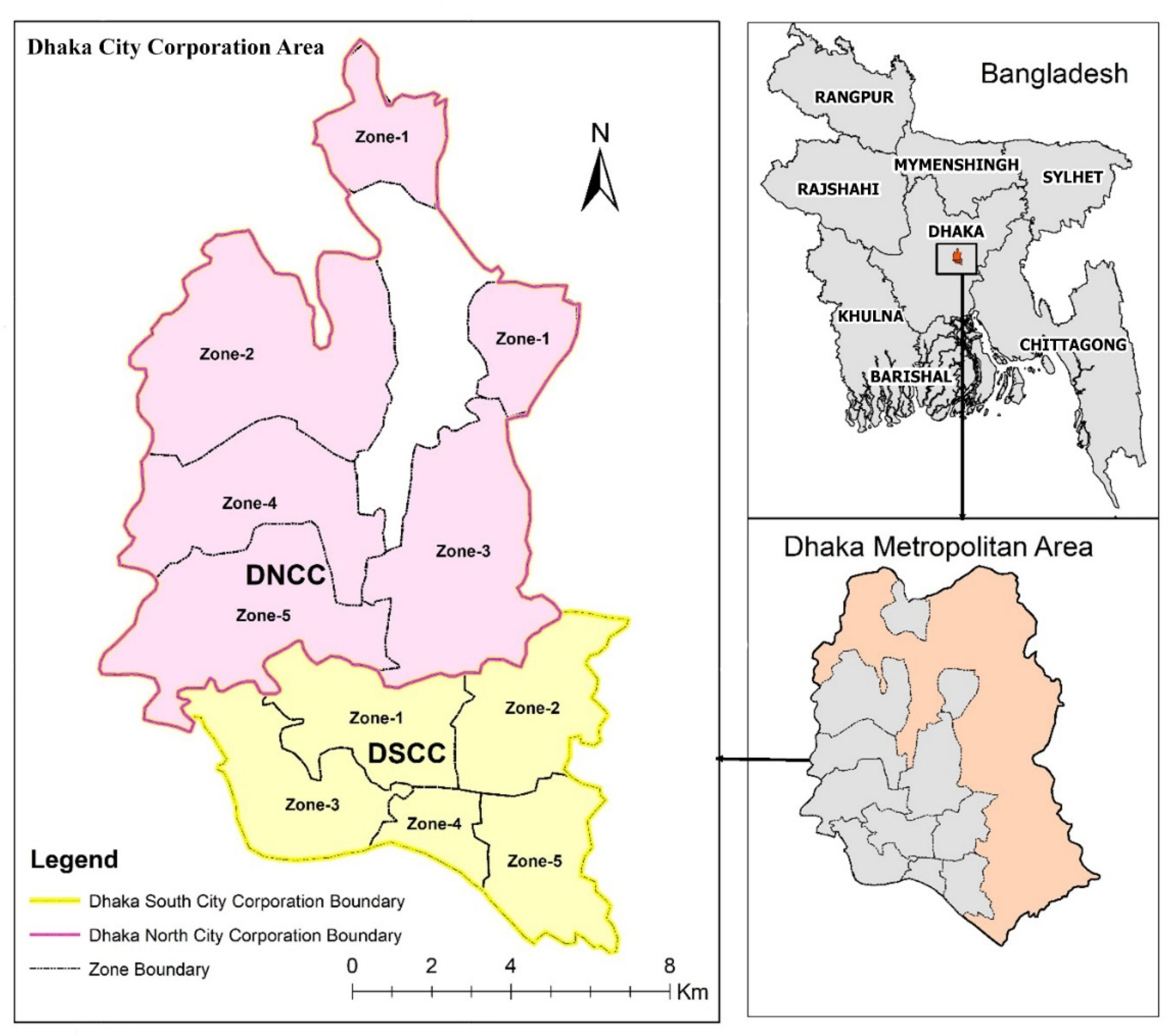

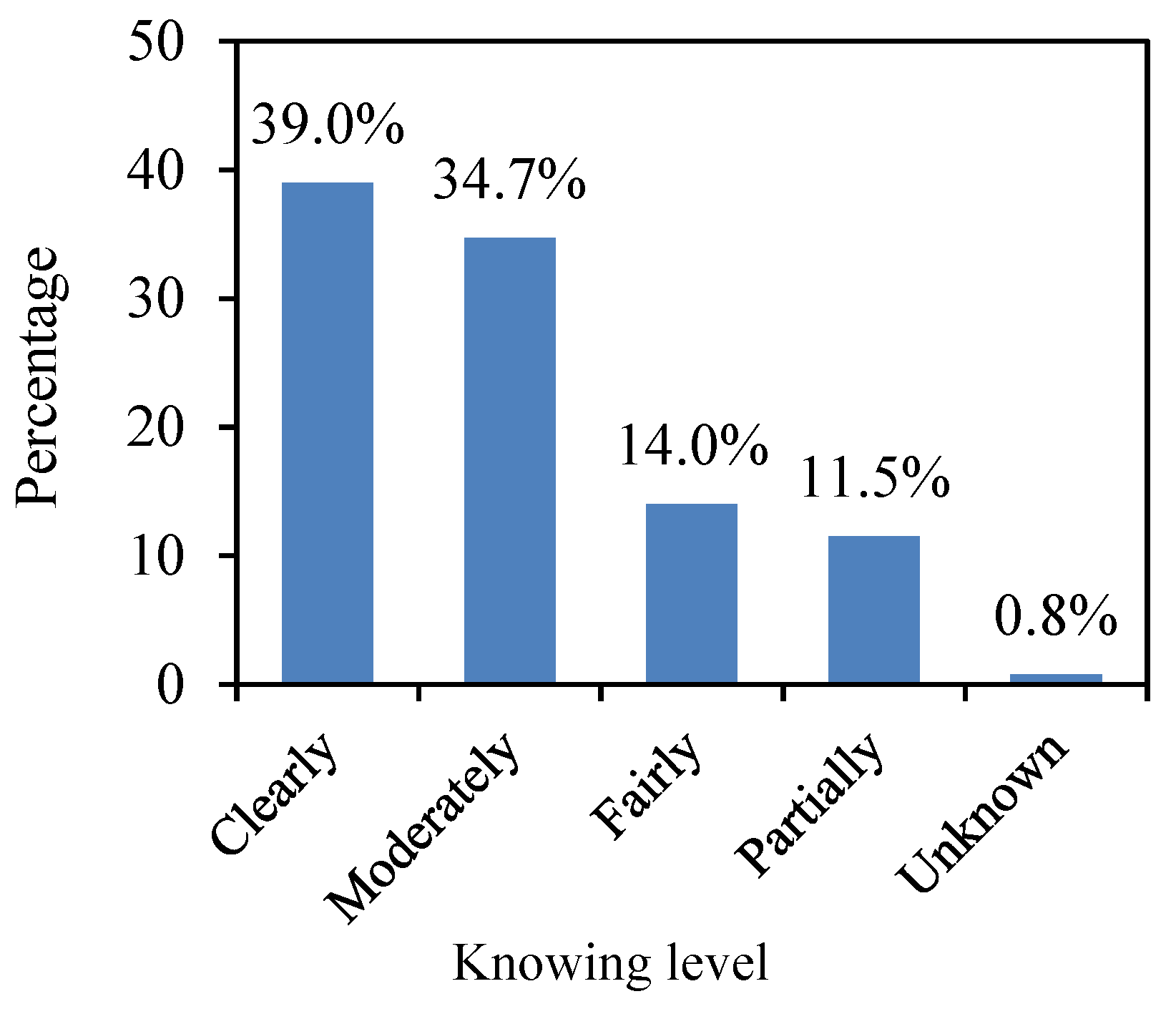
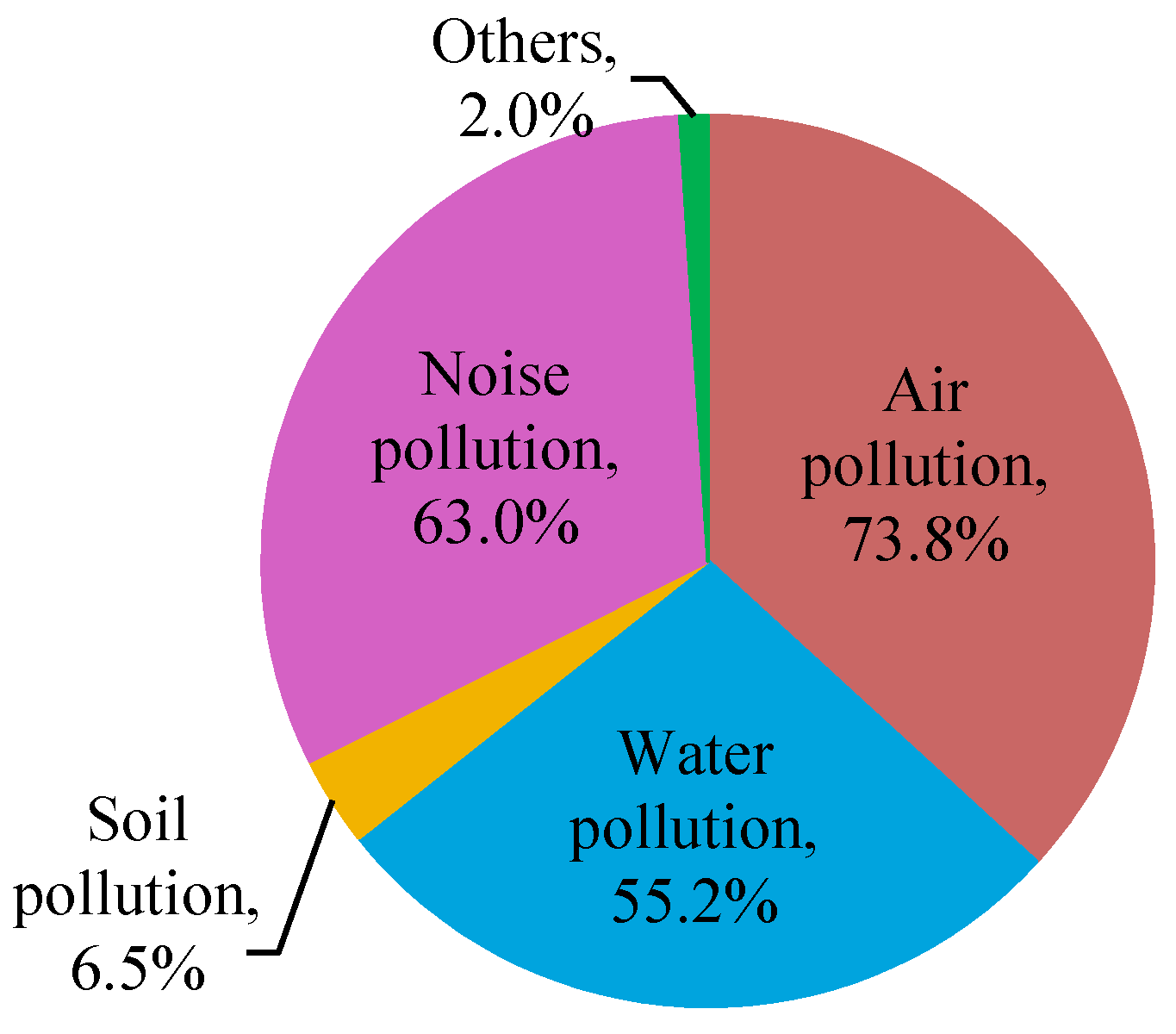
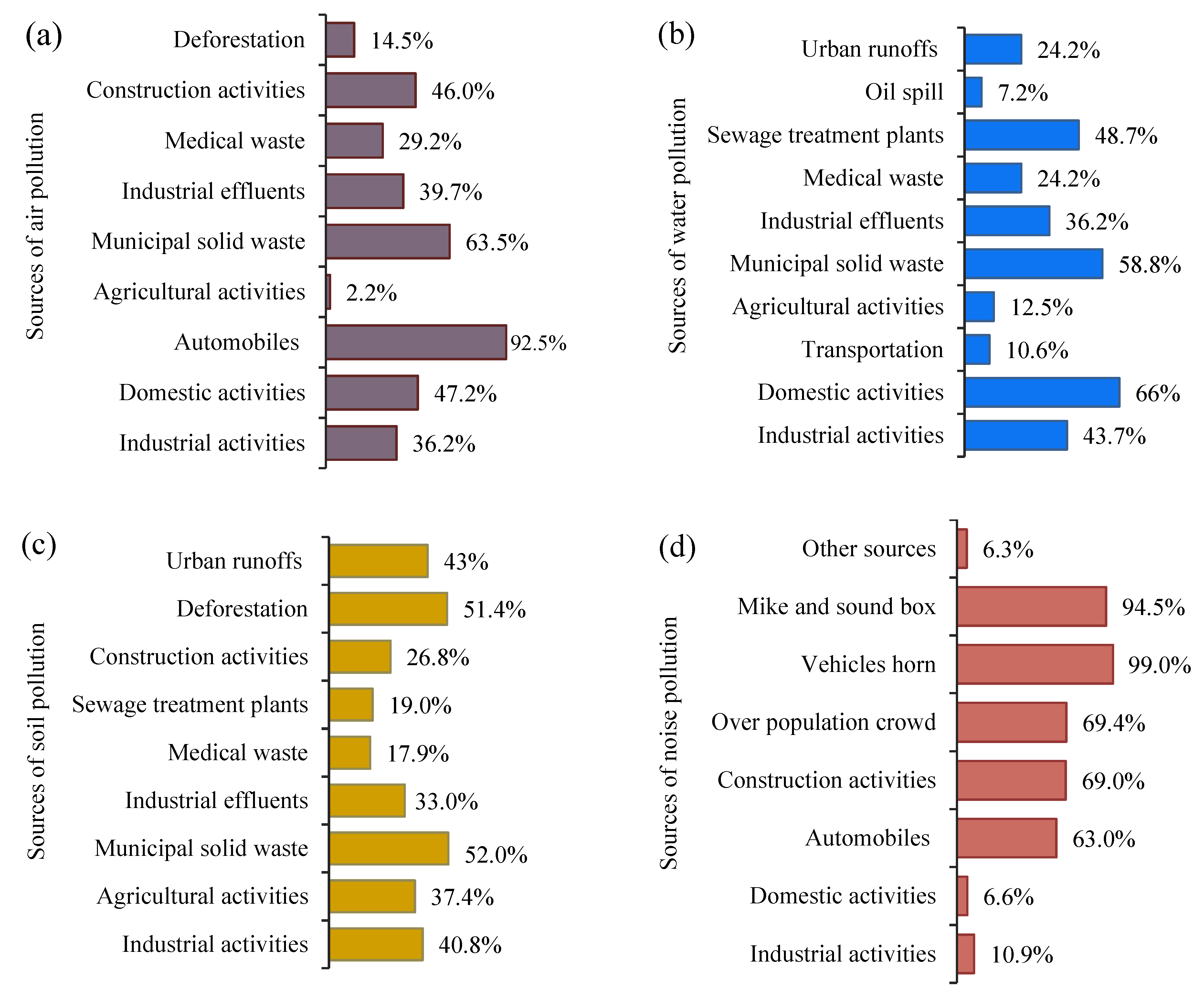
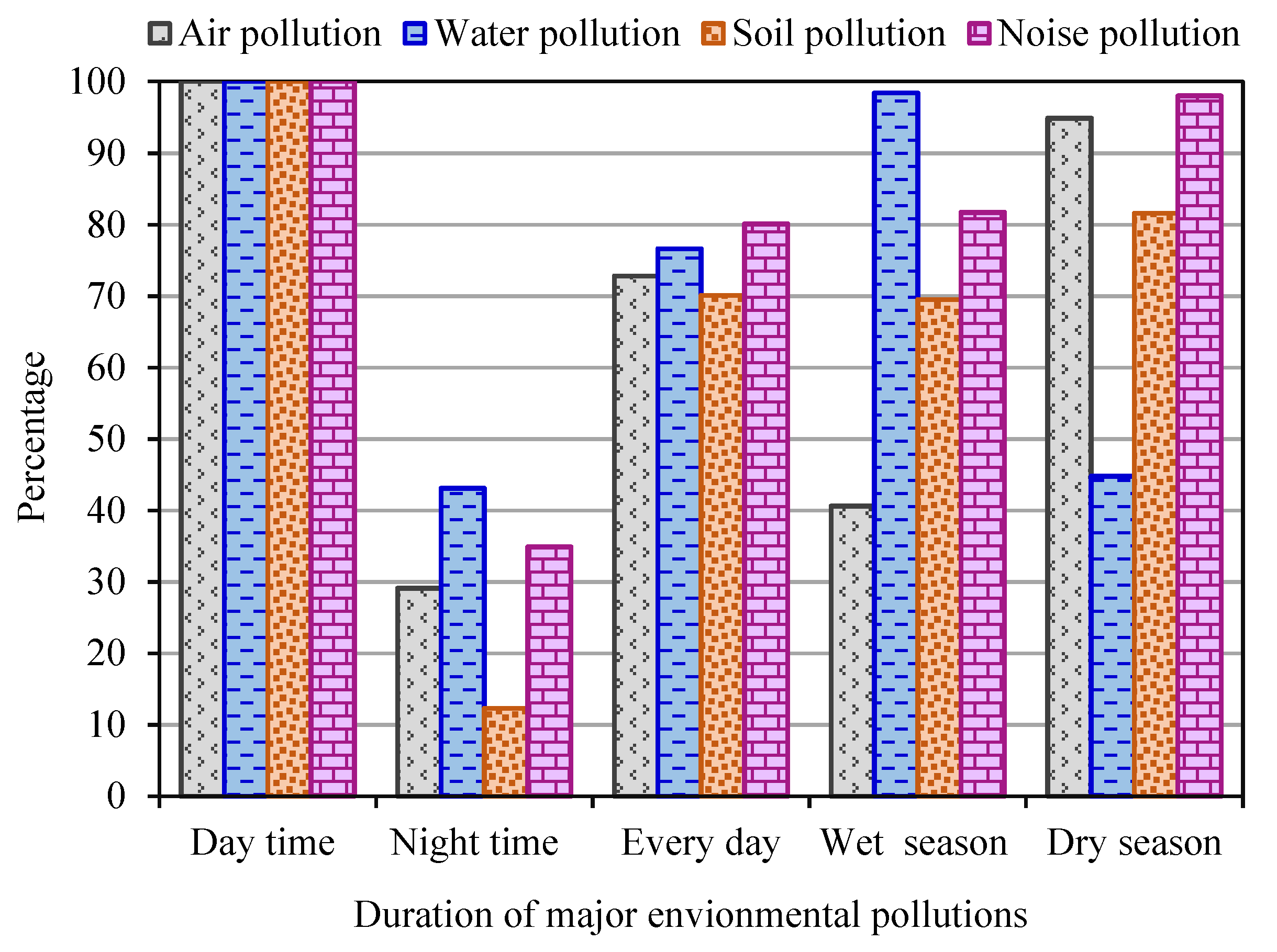
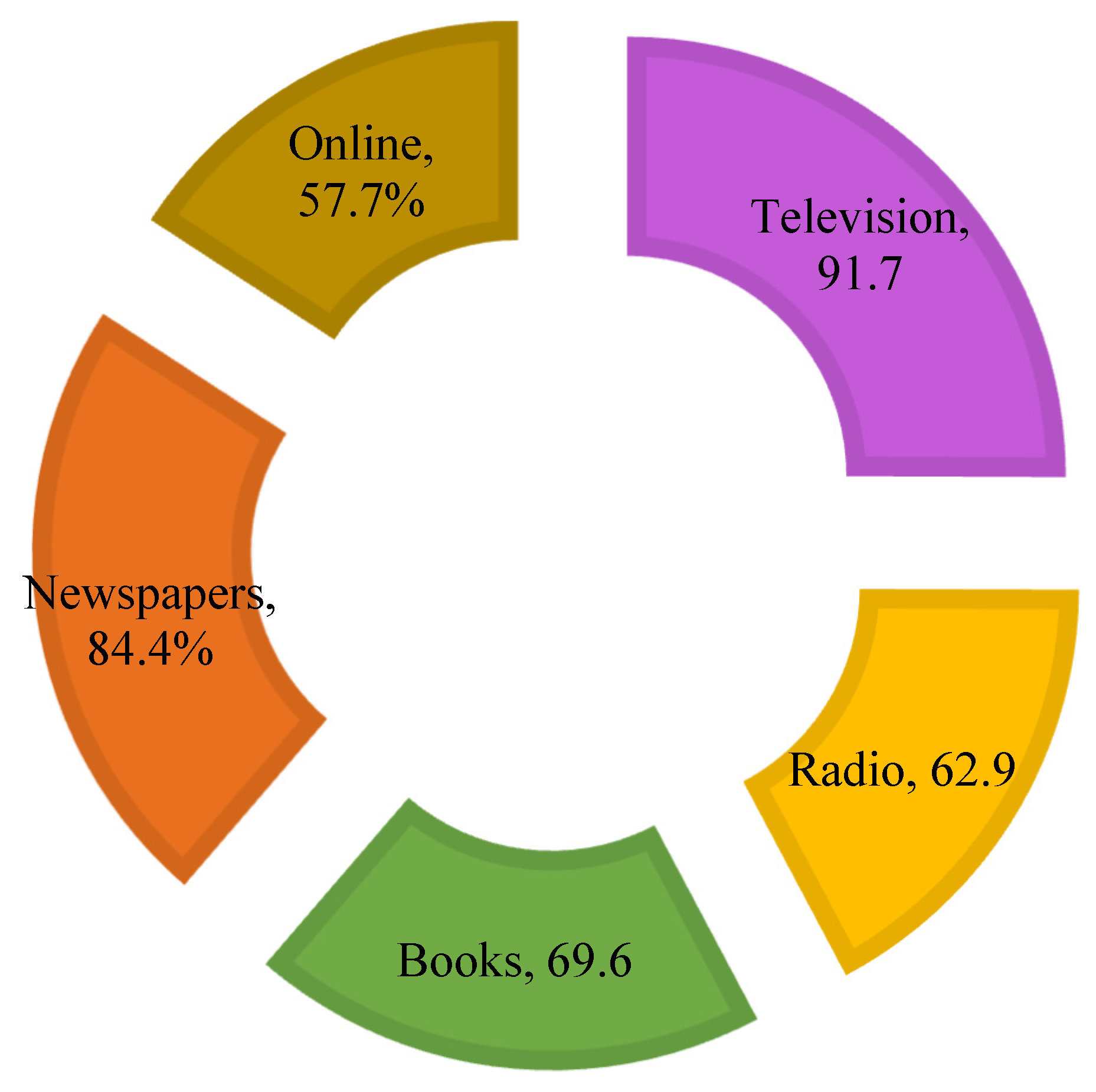
| No. | Major Sections | Questions |
|---|---|---|
| 1 | Demographic profile of the respondents |
|
| 2 | Primary knowledge about significant types, causes, effects, and sources of environmental pollution |
|
| 3 | Observation of pollution timing and duration |
|
| 4 | Effectiveness of current environmental programs and media preference for environmental information |
|
| Demographic Characteristics | Frequency (n = 400) | Percentage | Mean | Std. Dev. | Chi-Square (χ2) | p-Value | |
|---|---|---|---|---|---|---|---|
| Gender | Male | 265 | 66.3 | 1.34 | 0.473 | 42.250 | 0.000 |
| Female | 135 | 33.8 | |||||
| Age Group | 18–20 years | 6 | 1.5 | 2.95 | 0.772 | 152.140 | 0.000 |
| 21–30 years | 111 | 27.8 | |||||
| 31–40 years | 179 | 44.8 | |||||
| >40 years | 104 | 26.0 | |||||
| Religion | Hindu | 33 | 8.3 | 1.92 | 0.286 | 607.385 | 0.000 |
| Muslim | 365 | 91.3 | |||||
| Christian | 2 | 0.5 | |||||
| Marital Status | Unmarried | 90 | 22.5 | 1.81 | 0.489 | 575.740 | 0.000 |
| Married | 299 | 74.8 | |||||
| Widow/Widower | 8 | 2.0 | |||||
| Divorced | 3 | 0.8 | |||||
| Education Level | Illiterate | 16 | 4.0 | 3.26 | 0.822 | 195.860 | 0.000 |
| Primary | 48 | 12.0 | |||||
| Secondary | 151 | 37.8 | |||||
| Tertiary | 185 | 46.3 | |||||
| Occupation | Unemployed | 27 | 6.8 | 3.04 | 1.126 | 93.925 | 0.000 |
| Business | 112 | 28.0 | |||||
| Service | 134 | 33.5 | |||||
| Home manager | 74 | 18.5 | |||||
| Student | 53 | 13.3 | |||||
| Monthly Income | <10,000 BDT | 133 | 33.3 | 2.98 | 1.952 | 98.575 | 0.000 |
| 11,000–15,000 BDT | 26 | 6.5 | |||||
| 16,000–20,000 BDT | 45 | 11.3 | |||||
| 21,000–30,000 BDT | 110 | 27.5 | |||||
| >30,000 BDT | 86 | 21.5 | |||||
| Living Duration | <1 year | 6 | 1.5 | 4.07 | 1.044 | 238.475 | 0.000 |
| 1–3 years | 31 | 7.8 | |||||
| 3–5 years | 76 | 19.0 | |||||
| 5–10 years | 104 | 26.0 | |||||
| >10 years | 183 | 45.8 | |||||
| Causes of Environmental Pollution | Percentage |
|---|---|
| Rapid population growth | 40.3 |
| Unplanned and ill-planned urbanization | 88.3 |
| Deforestation | 69.5 |
| Improper waste disposal and management | 85.0 |
| Emissions from industries and automobiles | 74.8 |
| Emissions of fossil fuels | 48.8 |
| Chemical effluents from industries | 88.3 |
| Landfills by wastes | 87.6 |
| Construction works | 76.5 |
| Indiscriminate use of loudspeakers | 59.0 |
| Effects of Environmental Pollution | Percentage |
|---|---|
| Impacts on human health | 91.6 |
| Imbalances of ecosystems | 77.4 |
| Destroying the beauty of the city | 86.7 |
| Affecting the personal and working life | 92.0 |
| Global warming and climate change | 75.3 |
| Effectiveness of Environmental Programs/Activities | Percentage |
|---|---|
| Very effective | 28.5 |
| Average | 22.3 |
| Poor | 0.3 |
| Unknown | 49.0 |
Publisher’s Note: MDPI stays neutral with regard to jurisdictional claims in published maps and institutional affiliations. |
© 2021 by the authors. Licensee MDPI, Basel, Switzerland. This article is an open access article distributed under the terms and conditions of the Creative Commons Attribution (CC BY) license (http://creativecommons.org/licenses/by/4.0/).
Share and Cite
Nahar, N.; Mahiuddin, S.; Hossain, Z. The Severity of Environmental Pollution in the Developing Countries and Its Remedial Measures. Earth 2021, 2, 124-139. https://doi.org/10.3390/earth2010008
Nahar N, Mahiuddin S, Hossain Z. The Severity of Environmental Pollution in the Developing Countries and Its Remedial Measures. Earth. 2021; 2(1):124-139. https://doi.org/10.3390/earth2010008
Chicago/Turabian StyleNahar, Najmun, Sanjia Mahiuddin, and Zakaria Hossain. 2021. "The Severity of Environmental Pollution in the Developing Countries and Its Remedial Measures" Earth 2, no. 1: 124-139. https://doi.org/10.3390/earth2010008
APA StyleNahar, N., Mahiuddin, S., & Hossain, Z. (2021). The Severity of Environmental Pollution in the Developing Countries and Its Remedial Measures. Earth, 2(1), 124-139. https://doi.org/10.3390/earth2010008








